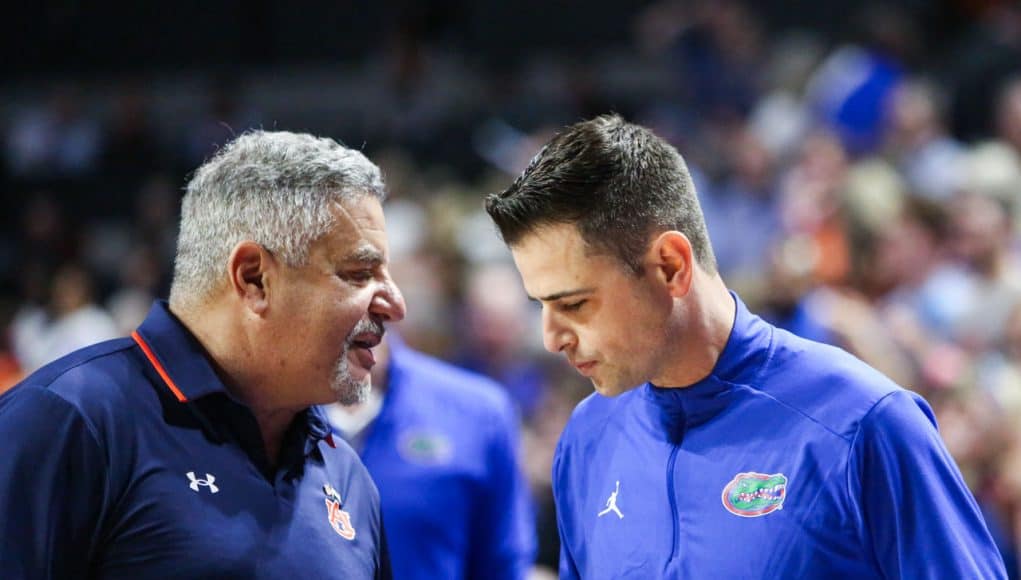When Todd Golden was hired at Florida he came in with an analytical approach, and he took the unshakeable belief in that style into whatever game the Gators were playing. Given that, it seemed rather poetic that the Gators would find themselves in a National Championship game with a Houston Cougars team who, well–couldn’t be more on the opposite side of the spectrum.
Florida is all about an analytical approach to shot selection, and that approach is about taking most of your shots either at the rim or from three-point land. Houston, a team that doesn’t care about analytics, was 357th in the country in shots at the rim, 287th in three-point attempt rate, and 1st in the country in mid range jump shots. Admittedly, college basketball is guilty of making just about every big game a referendum on something in the sport, but it seemed narratively satisfying to have a championship game between two teams that see the game through completely different lenses.
Before we even talk about what happened, it’s important to note that this wasn’t the first game where the Gators’ analytical lean was on display. For that–you’ll want to start with the Texas Tech game. The Red Raiders are a team with a number of excellent post players, and they were going to make it a focus to get the ball inside and attack some of Florida’s less muscular bigs. Now, in some scenarios, a coach would look at this and decide they need to send double teams. Not Todd Golden. Double teams open up passing out opportunities, and it can turn less efficient post possessions into much more efficient catch and shoot three scenarios.
In the first half the Red Raiders scored repeatedly on post ups, and with each score they seemed more keen to go back to the strategy. But Florida, sound in their analytical belief, would not send more help–and things started to swing back in Florida’s favor. Ultimately Texas Tech logged 13 post up possessions and scored just 11 points on those attempts–less than a point per possession, which is where every great defense lays.
This exact script happened again against Auburn. The Tigers were going to force the ball into Johni Broome down low, and Florida was going to leave their defenders on an island to guard one on one, with no help that could potentially open up a three-point attempt coming. Once again we saw Florida’s opponent scoring early but not able to maintain it, and Auburn had 12 post up points on 13 possessions.
Finally, the Gators saw Houston, arguably the team that plays the least analytically minded style in college basketball.
What happened? Houston took a ton of the exact shots that Florida was willing to give up. In fact, Houston shot 17 midrange jumpers. How many points do you think they gained from these shots?
10.
10 points on 17 shots is not going to win you basketball games at many levels, and that’s exactly what Houston ran into against the Gators.
How many midrange jumpers did the Gators shoot, you might ask? 2–and they missed both of them.
Houston continuing to hammer away at low-value attempts was the biggest reason Florida was able to turn things around in the second, with the Gators repeatedly getting shots with higher returns that at some point was certain to turn in their favor.
Finally, let’s talk about the concept of a “two for one.” With college basketball having a 30 second shot clock, you can sometimes be put in the situation to game the final minute to get one extra possession than your opponent. Say you get the ball with 45 seconds remaining. If you take a shot in the first 4 seconds, there are 40 seconds remaining. Your opponent is likely to shoot in 20-30 seconds, and if you get the rebound you’ll have 10 seconds left. You then have two possessions to your opponent’s one (thus, the “two for one”) as opposed to holding onto the ball initially and putting yourself in a position where you and your opponent both have a single shot. This is a strategy the Gators have employed in a number of situations this season, and they look to use it whenever possible.
If you were watching the Championship game, you would have heard the announcers talking about whether or not Houston would use the “two for one” when they inbounded the ball with 46 seconds left. Of course–this would be literally the perfect time to use this strategy, and if executed correctly would have likely given Houston a more probable chance to win than Florida.
But–Houston is not an analytical team. They dribbled the ball and took a ton of time off the clock, ultimately turning it over with 26 seconds remaining.
And with that, we saw a perfectly fitting end to Florida’s season–they used an analytical approach, and ran into teams that didn’t. It’s not the only reason that Florida was able to win, but it was a perfect example of how they could use analytics to get a massive edge on their opponents.



How about those Gators Eric –
Enjoyed your recent You Tube swing through the UF Podcast Community.
Tough game but you were correct in the end, UF’s style beat Houston’s, but just barely.
UF – 7-3 in FF’s since 94. 6 Appearances.
3 Natty’s.
Not many teams have such a high FF winning % and collective titles.
It’s Great to be a Florida Gator!